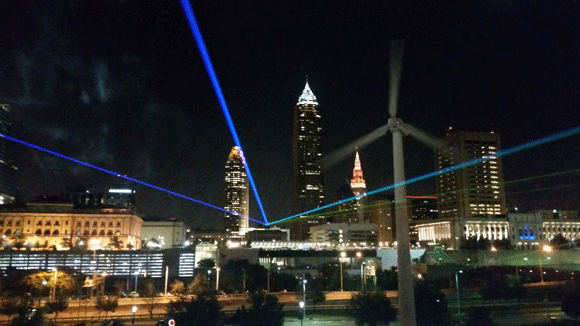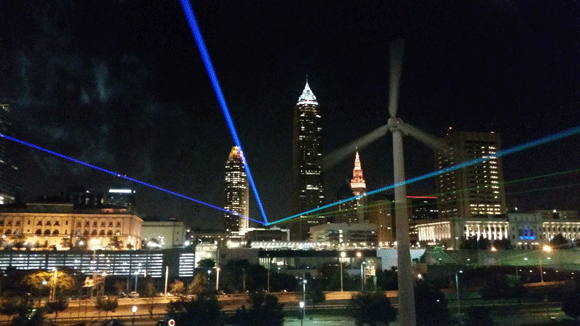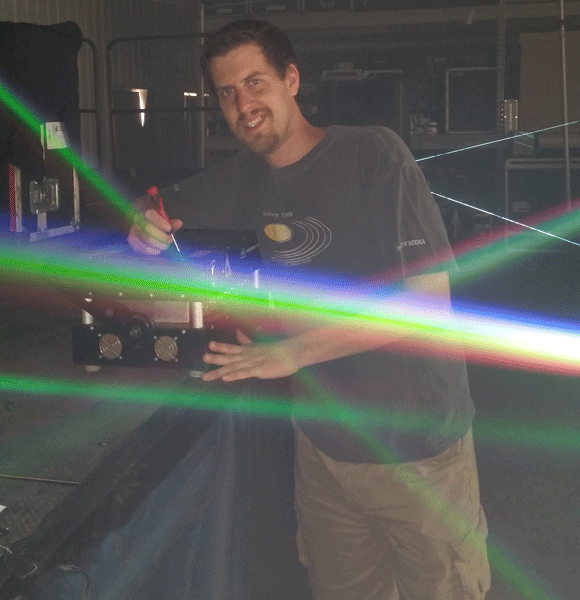Two years ago, Mark Nath was in Miami working on laser effects for Ultra Music Festival, an event that draws 100,000 people every year.
“How’s it going?” a man asked while he worked on the stage.
Nath didn't turn around to face him, instead focusing on the equipment that would make the concert a memorable experience the gathered throng.
The man continued to pester him, asking benign but friendly questions.
“I was at my wit’s end,” recalls Nath. “I was about to snap and tell him, 'I'm trying to work here. Leave me alone.'”
The personable — yet irritating — man then took the microphone and launched into a set of songs that would be familiar to anyone who has tuned into popular radio in the last two decades. It was Usher.
“I did not recognize him because his hair was (different),” says Nath. “I was thankful I didn't snap at him.”
Nath, 32, of Bridgeville, has an abundance of stories like that from his travels working for artists such as Lady Gaga, Jay-Z and Swedish House Mafia. Nath is a concert laser designer for Lightwave International, a company based in Eighty Four, Washington County.
The demanding travel schedules of the team at Lightwave are both rewarding and taxing.
George Dodworth, 39, owns the company. He cites an employee that has filled his passport at least three times as an example of how adventurous their jobs are.
At his office, Dodworth flips through the company's travel log which shows visits to Prague, Czech Republic; Budapest, Hungary; Barcelona; Milan; Cologne, Germany; and Leipzig, Germany. And that's just this year.
“There’s no way the most ambitious traveler could pack in the places the way we do on a tour,” he says. “On a tour bus, it may sound like a dreadful experience. But I’ve woken up on the bus, and it's quiet and smooth. I'm like, ‘Where the heck are we?’ And the tour bus is in the belly of a cargo ship crossing the North Sea.”
In 2006, Dodworth took out a second mortgage on his home to buy the company's first laser. (He will not reveal how much it cost.) From there, he connected with noted laser-lovers Pink Floyd, who asked him to make a prism of lasers for one of their shows. The company's reputation has since landed them gigs with Madonna, Rihanna and Snoop Dogg, to name a few.
A 2000 graduate of Chartiers Valley High School, Nath graduated with a computer information science degree from the University of Pittsburgh in 2005. During his student years, he worked at local nightclubs and bars, which is how he got into laser and lighting design.
Eventually he collaborated with Lightwave. They appreciated his work, and offered him a full-time job.
The company's operations are based in a warehouse on Dodworth’s property in Eighty Four. The large building houses state-of-the-art laser equipment and a mock stage with cryogenic jets shooting nitrogen blasts that look like steam coming from a broken water main.
Nath and his fellow employees work 9-to-5 jobs at the warehouse when they're not at a venue or on tour. When they’re on the road, they may work as many as 20 hours consecutively. Nath recalled the 2012-to-13 New Year’s Eve at Pier 94 in New York City. He worked 26 straight hours at the nightclub, with the only relief coming from the occasional 15-minute break.
“You kind of get to a point if you push through it,” he muses. “You get loopy and sleep deprived, but after that you start thinking of equipment and getting home, then think of how many days you get off.”
“People say my job is amazing. And it is,” he adds. “You get to do stuff and say ‘I did that,’ which is a cool feeling. But what people don’t understand is that for every proud moment, there is 100 hours behind that of research, meetings, e-mails, airplane flights and logistics that go on.”
Occasionally the employees at Lightwave get to blow off steam by partying with some of the celebrities they work for. Eric Prydz, a prominent Swedish DJ who headlined at Ultra Music Festival this year, showed them a good time. Prydz is known for his 2004 hit — and provocative music video for — “Call on Me,” which was a remix of Steve Winwood’s 1982 hit “Valerie.”
Unhappy with the first night of a two-concert performance in New York City, Prydz asked for help from the company. Nath flew in with his coworkers. After they fixed the problem, Prydz took the laser gurus to area nightclubs.
Nath also helped prominent lighting designer Johnny R. Goode develop shows for the Disco Biscuits, a Philadelphia jam band known for their combination of electronic and rock music. Goode says that one laser show at Red Rocks Amphitheater in Colorado was particularly impressive because it was staged outdoors.
“I had never really come across the technology I was looking for,” says Goode. “They were the ones who had the products I needed. I asked around and got in touch with them. I feel like they are the by far the best laser company in the market. They were the originators of the full-color high-power laser shows.”
For Nath and his colleagues, the best moment is when they’re at a performance, in a control center, anxiously awaiting the moment when they have to push the button that will start the laser show. They don’t know if it will work. Their reputation and livelihood rides on it.
“There’s always that feeling of nervous anticipation before you hit that button,” explains Nath. “Then the crowd explodes. It’s a fun time. I’ve done hundreds of shows, and I still get goose bumps every time (when that happens).”



